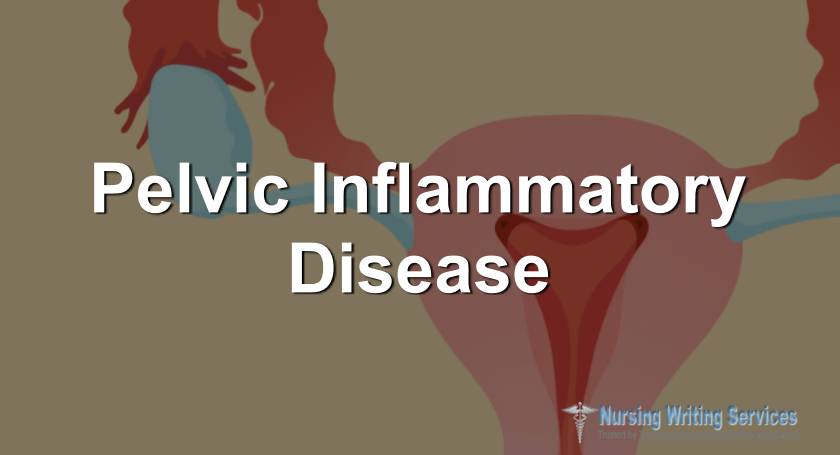
Pelvic Inflammatory Disease
Pelvic Inflammatory Disease (PID) is one of the female reproductive health condition that involves the inflammation of the organs found in the pelvic cavity and or floor (Hinkle & Cheever, 2017). PID can either be cervicitis, salpingitis involving the fallopian tube, endometriosis, or swelling of the ovaries. Inflammation of these organs can either be acute, severe, or chronic, depending on the causative agent. It usually occurs from a bacterial cause. Mostly, the condition is not a primary disease entity but a complication of either urinary tract infection or the sexually transmitted infection (Kreisel et al., 2017). During its early stages, the disease is asymptomatic, but the symptoms become prominent as the condition advances if not identified and treated.
Clinical Presentation.
Pelvic Inflammatory Disease usually presents with symptoms that are localized to the pelvis and reproductive systems and also other systems and organs in the body (Kreisel et al., 2017). Pain in the lower abdomen is the first symptom of PID. Patients with this condition usually complain of sharp piercing pain in either or both of the lower abdominal quadrants. Other patients will complain of a burning sensation that radiates either to the back of the lower extremities (Hinkle & Cheever, 2017). Different pain characteristic is due to the various causative agents and organs involved. There is vaginal discharge in PID patients. The characteristic of the discharge is abnormal smell or odor. The amount of the discharge also varies with patients with PID. The majority will have heavy and uncontrolled bleeding both during and after the usual menstrual cycle (Brunham, Gottlieb & Paavonen, 2015).
Urinary tract symptoms are also present with PID. There is difficulty in urination accompanied by severe pain. Such symptoms will occur if the disease is related to a urinary tract infection. Abnormal sexual intercourse is another symptom of PID. With this condition, the patient will complain of pain sex accompanied by severe bleeding. Such symptoms occur if the disease results from a complication of a sexually transmitted infection (Hinkle & Cheever, 2017).
ALSO READ:NURSING ASSIGNMENT WRITING SERVICE
Abdominal and other systemic symptoms are also evident among patients with PID. Gastrointestinal symptoms include reduced appetite, nausea, and vomiting. Bowel discomfort is also present during PID disease (Brunham, Gottlieb & Paavonen, 2015). Headache and generalized body weakness are the other symptoms of the disease. On palpation, the abdomen might be tender of indicative of swollen organs in the pelvic cavity. As a result, pelvic examination through radiological studies is essential to determine the organs involved (Hinkle & Cheever, 2017).
Physical Assessment.
The diagnosis of the pelvic inflammatory disease depends on the findings of laboratory tests and the physical or systemic assessment. Physical assessment focus on the visible symptoms of the disease through inspection, palpation, and radiological examination of the organs involved. Analysis of the characteristic of abdominal pain is the priority assessment (Brunham, Gottlieb & Paavonen, 2015). The evaluation will focus on the location, nature, and factors that either relieve or precipitate the pain. Palpation of the abdomen focuses on the nature of the ovaries, bladder, and uterus. These three organs can be inflamed or swollen with this condition (Hinkle & Cheever, 2017). Use of and radiological imaging helps to isolate the organs impacted the inflammatory condition hence informing the best approaches to be used in treating the condition. Using laboratory tests and cultures helps to identify the specific agents or bacteria responsible for the inflammatory process hence informing on the choice antibiotic agents to be used for treating the patient (Brunham, Gottlieb & Paavonen, 2015).
Clinical Management
Clinical management of pelvic inflammatory disease involves preventive, curative, and rehabilitative approaches. The main goal of these approaches is to eliminate symptoms, present complications, and promote patient recovery and restoration of normal reproductive health. Drug therapy involves of use of antibiotics to treat underlying causes and analgesics to reduce pain (Savaris et al., 2017). Bleeding may result in a significant loss of blood; hence, the patient may be transfused. Normal fluid replacement therapy through intravenous solutions is also recommended. Nursing management usually involves supportive and rehabilitative activities for the patient. Evaluation of the patient for response to drug therapy is another role of nurses in managing patients with PID (Ross, Guaschino, Cusini & Jensen, 2018).Also, nurses monitor patients for disease progress and reaction to medication and take necessary actions to prevent patient. Nurses educate patients and their partners on the importance of having single-sex partners to prevent contraction of the disease. For patients with a history of sexually transmitted infections, temporary abstinence is essential for the patient to promote quick recovery (Brunham, Gottlieb & Paavonen, 2015).

